Much of northern Central America was devastated by a cataclysmic volcanic eruption, probably during the fourth century A.D. What had been a verdant tropical landscape dotted with agricultural villages and some large ceremonial centers, with their elegant pyramids and palaces, was suddenly transformed into a white desert by immense amounts of tine volcanic ash. The source was a vent that opened up under Lake Ilopang. The combination of the violence of the eruption and the explosions of steam (from hot magma contacting lake water) resulted in one of the most violent eruptions that Central Americans had ever witnessed. About a century of weathering, soil formation, and vegetative recovery was necessary before people could recolonize the area.
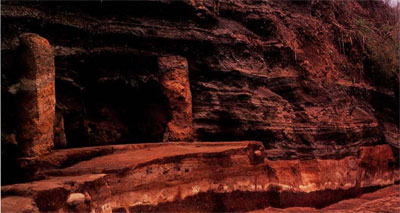
Those events and processes are preserved at the Ceren site in the center of what is now El Salvador. There, a white layer on top of fertile soil is the remains of the Ilopango volcanic ash — before weathering it was probably about 3 to 4 feet deep — that caused the complete depopulation of central and western El Salvador. Ceren was one of the first villages colonized after the area recovered ecologically. It was probably established in the early sixth century, and the inhabitants had to dig down below the Ilopango ash to get clay to build their structures.
Surprises on the Menu
Ceren was a thriving village of some 150 people in the southern periphery of the Maya area about A.D. 600. Although only a few generations lived there before Ceren was entombed by the next eruption, they developed a surprisingly high quality of life. Even though they were all commoners, all families lived in highly earthquake-resistant architecture with plenty of room inside the walls and under the ample eaves of their thatch roofs. Each household had at least three separate buildings: a domicile for crafts, activities and sleeping; a storehouse; and a kitchen. Each household had more than 70 complete ceramic vessels for such functions as cooking, storage, and serving of Food and drink.
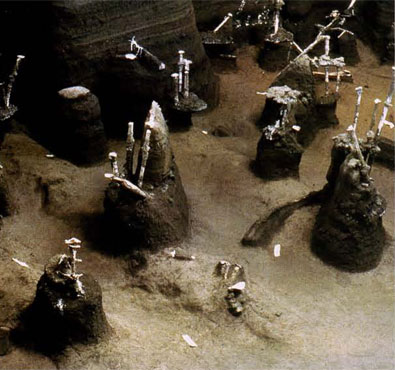
Before our excavations at Ceren, most specialists in Mesoamerica would have expected the diet of a small village of commoners to have been largely maize (Indian corn) with some beans, a bit of squash, some chilies, and occasionally some other species of food. Their diet was actually quite varied, based on the foodstuffs grown in their gardens and fields and stored in their buildings. A very unusual archaeological site, Ceren is the perfect place to investigate ancient diet because the Loma Caldera volcanic eruption preserved the crops in gardens, fields, and orchards, as well as flowers, weeds, bushes, and trees.
But how exactly were all the plants preserved? A volcanic vent opened under the Rio Sucio, the large river that drains the Zapotitan valley. This point was only half a mile north of Ceren, at the Loma Caldera volcanic vent.
The earliest eruption stage would have been noisy, with screeching from the steam indicating danger. Apparently that was enough warning, as everyone fled the village, at least as far as we can tell to date. Then, the explosive component of the eruption began when the hot magma rushing upward contacted the river water and resulted in a violent steam explosion, blasting a cloud of steam and fine volcanic ash in all directions. That fine, moist ash plastered itself around corn plants, trees. and everything else in the area. It dried somewhat firm and hard, and when the encased plants decomposed shortly after the eruption, hollow spaces were preserved from the seventh century and were still there when we began to excavate the site in 1978.
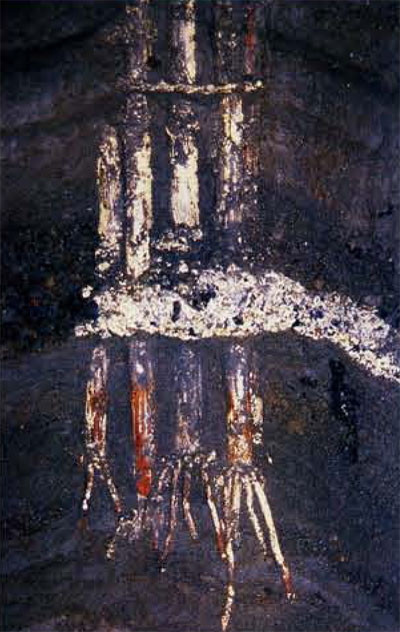
When students from the University of Colorado and I are excavating through the Loma Caldera volcanic ash, we often come across those hollow cavities where a plant had been. We carefully inspect each cavity with a fiber-optic proctoscope to determine the species and the volume of dental plaster needed to make a precise and permanent cast of the plant. This process gives permanence to what nature intended for only a season. Ceren provides us with an unusually detailed record of what was growing where, and when we combine that with the various foods stored in buildings, we can reconstruct with more accuracy than at most archaeological sites what the ancient inhabitants ate and drank.
Awash in Timing
Dating the Loma Caldera eruption has highlighted some of the ironies of archaeological time control — we have been more successful in pinpointing the smaller units of the month, and even the time of day, than we have been in determining what year the cataclysm occurred. The many radiocarbon samples we have dated indicate it probably happened in the early to middle seventh century A.D., but we may never know the exact year. However, the seasonally sensitive plants all indicate that the eruption occurred in the middle of the rainy season, in August. And as we study the patterns of artifacts in the households, they indicate that the evening meal has just been served but the dishes have not been washed, telling us the eruption occurred around 6 P.M. to 7 P.M.
The kitchen garden of Household 1 had crops growing on neat ridges, and alternating species in a pattern I call “zoned biodiversity on one ridge were some manioc plants that look like small trees with huge carbohydrate-rich roots underground. The next ridge was loaded with maianga (Xanthosoma), another root crop that provided much more carbohydrates to Ceren residents than did manioc. In fact, malanga is second only to maize in total calories provided. The next ridge had flowers, followed by the final ridge with a medicinal plant whose sap is a mild antibiotic.
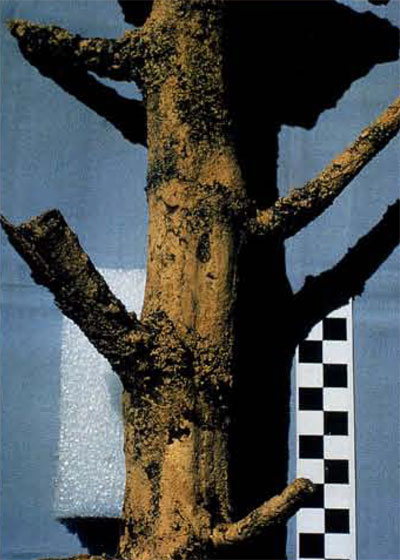
Beyond the kitchen garden, and fully surrounding each household, were the milpas where Cerenians grew corn, year after year, beginning early in the rainy season. Three or four maize seeds were planted together atop low ridges, and they grew as a cluster. Almost every maize stalk had a single ear, and from the size of the ears and maize kernels we calculate the dry-weight maize productivity at about 5,000 kilos per hectare (over 27,000 pounds per acre). This is extraordinarily high productivity, which we attribute to fertilization by people’s personal waste as well as kitchen scraps and wood ash from the hearths. It also resulted from the fertile soils developed from volcanic ash, and the abundant precipitation (average 1,700 mm, or 67 inches, per year). While this productivity figure is accurate for the cornfield adjacent to the household, we cannot assume that the entire cornfield matched this productivity level. The productivity probably drops moving away from the household, as less fertilizer would be applied farther away. Also, animals and birds would eat more maize farther from the active household, and if people from other households swiped corn, they would do it more from the peripheries.
The Cerenians were just harvesting their first maize crop when the eruption struck and entombed the site. Right before that eruption, villagers were beginning the interpolating of beans with maize, a common practice in traditional agricultural areas of Central America today. (Beans fix nitrogen for the next maize crop and maize is nitrogen demanding.) It is probable that, had the eruption not occurred, squash would also have been interplanted between the mature corn plants and the young beans. Abundant corn, beans, and squash have been found stored in household buildings.
Household 4 at Ceren had a large garden plot for special foods. The people grew chilies in great amounts, probably enough to supply the entire village. They also produced chocolate, grown on cacao trees. The nearby Structure 4 had cacao seeds stored in four different ceramic vessels. One of those also contained chili seeds, presumably indicating the first step toward making a mole sauce. In other cases, the ancient Cerenians probably sweetened their chocolate beverage with honey. The Household 4 residents also ground cotton seeds, presumably to obtain oil for cooking.

The combination of corn, beans, and squash, with carbohydrates from manioc and especially malanga, and vitamins and minerals from chilies, provided a virtually complete diet from a nutritional standpoint. Tree fruits, including nance, avocado, and guayaba, were also important to the diet. Villagers ate protein in the form of deer, dog, snails (the large “jute” snail that the French call escargot), and duck (one was found tied by the foot to a wall pole in the storehouse of Household 1). The diet of the ancient Ceren commoners was more balanced and varied than we had previously suspected.
Storing and Serving Food and Drink
Having seen how the crops were grown, the question now is, how was food stored, processed, and consumed? Chilies were stored in every household on strings suspended over the rafters. Corn was stored in the field temporarily where it was growing, on the stalk. It also was stored in corn bins in household buildings. Beans and squash were stored in numerous pottery vessels.
One of the surprising aspects of Ceren is the elegance of its food- and drink-serving vessels. Almost all of the serving vessels were colorfully painted with depictions of people, deer, monkeys, birds, caimans, or other elements of the environment. Fully one-fifth of each household’s ceramic inventory was composed of these serving vessels. The vast majority of these painted vessels were manufactured in the Copan valley, 120 kilometers to the north, and traded into Ceren. Tortillas had not arrived in the Ceren area yet, hut the inhabitants consumed tamales in large numbers, serving them in four-legged plate vessels elegantly decorated inside and out. Pasty foods, such as ground maize gruel, were served in hemispherical vessels that likewise were decorated inside and outside. Liquids were served in cylindrical vessels that were painted only on the outsides. Liquids included water, cacao (chocolate from cacao trees), and perhaps chicha (a fermented maize beverage).

Putting the above together, we can get a pretty good idea of the common meal at Ceren. A gruel, probably of ground maize often mixed with beans and spiced with chilies, was served to family members in the hemispherical bowls. Frequently, it must have had malanga in it as well, and occasionally manioc. It likely also contained meat upon occasion, but not as regular fare. Cerenians used the first three fingers of their hands to scrape the food from the bowl and take it to their mouths. They drank water out of their cylindrical vessels, but on special occasions they would drink chicha or chocolate from these same vessels. The four-legged plates for serving tamales were not as common in households as were the bowls or cylindrical drinking vessels, and that probably indicates that tamales were eaten less often. The elegance of decoration of the plates probably indicates that they were a special-occasion food, and were probably stuffed with deer meat or protein from one of the other sources available to them.
There have been many surprises from the excavation of the ancient Ceren village, and many of them involve food and drink. The diversity and abundance of foods in a commoner village are far greater than we expected to encounter. Cerenians would have had to produce significant surpluses to exchange for all their colorful decorated serving vessels, imported from far away. This can only indicate the importance of sharing food and drink within the household, certainly a glue that held the family together generation after generation.

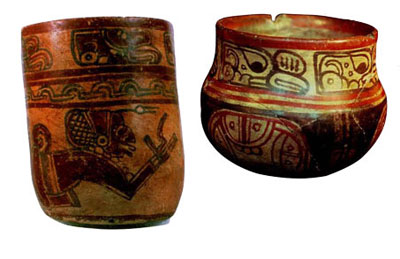
Acknowledgments
I thank the research crew, composed of dedicated Salvadorans and North Americans, for their efforts year after year. The research could not have been done without the assistance of officials in Concultra, Ministry of Education, San Salvador. Michelle Woodward and I have collaborated on the details of agricultural production at Ceren, and her work on maize productivity is reflected here. I appreciate the many conversations about traditional agriculturalists I had with the recently deceased Dr. Carol Kramer. This article is dedicated to her memory, her humanity, and to her towering scholarly accomplishments.
Payson Sheets received his Ph.D. from the University of Pennsylvania in 1974, working on the very end of the Tidal project and especially on the Chaichuapa project, supervised by Dr. William Coe and Dr. Robert Sharer, respectively and respectfully. Sheets has directed research projects in Panama, Costa Rica, and El Salvador, investigating the relationships among people, societies, tropical environments, resources, and explosive volcanic eruptions. He teaches at the University of Colorado in Boulder.
For Further Reading
Lentz, David, Marilyn Beaudry-Corbett, Maria Luisa Reyna de Aguilar, and Lawrence Kaplan. “Foodstuffs, Forests, Fieids, and Shelter: A Paleoethnobotanical Analysis of Vessel Contents from the Ceren Site, El Salvador,” In Latin American Antiquity 7(3) (1996): 247-262.
Sheets, Payson. The Ceren Site: A Prehistoric Village Buried by Volcanic Ash in Central America. Fort Worth, TX: Harcourt Brace, 1992.
Sheets, Payson, ed. Before the Volcano Erupted: The Ancient Ceren Village in Central America, Austin,TX: University of Texas Press, 2002.
Sheets, Payson. “Tropical Time Capsule,” In Archaeology 47(4) (1994): 30-33.
